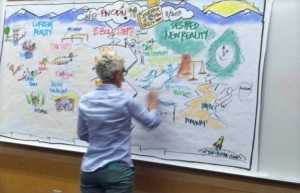My artistic career ended in third grade. In fact, after I received a B in Mrs. Potter’s art class, I figured that I had no talent at all. “Stick to writing words”, I told myself. That self-talk lasted fifty years.
More recently, I’ve recanted and acknowledged some artistic things I can do – such as create Ikebana flower arrangements– so it’s not over for me yet. But the fact of the matter still remains: I can’t draw.
This didn’t matter at all to Patti Dobrowolski, whom I heard at a recent evening event on Visual Goal Setting. Patti is a former actress, business consultant, creativity consultant, visual strategist, visual process facilitator, and captivating wild woman. With great enthusiasm, she reassured us drawing drop-outs that we would do fine just sketching stick figures.
One of the purposes of drawing our goals was to activate the power of the right (imaginative) side of the brain, which, fortunately for me, does not do critical evaluations of artistic talent.
I was sitting next to my friend and collaborator Claire Bronson, who had introduced me to Patti’s work a year ago. Claire is herself a visual facilitator who can turn a flip chart into a work of art, and make even a word look beautiful. (see her words at engagingpresence.com/approach). I made a mental promise: don’t even think of comparing my drawing with Claire’s!
Developing visual goals
Patti gave us copies of templates for her visual mapping process and we began. Step one in her process is to reflect on current reality – “what’s going well in your world and what’s challenging you?” She asked us to capture the essence of our thoughts and feelings in one-word statements. “Don’t make a list,” she told us because lists belong to our left-brain organizing, linear self – not to the creative, knowing, more random right-side of the brain that we were to encourage in this exercise.
Putting down words wasn’t hard for me because I’m pretty aware of what is working in my life right now and what I’d like to change – so I scattered words that described my current life: “Mariah the wonder pony” (captures my heart); “Great group” (love my current leadership program clients); “Fear of the future” (yikes, this economy???) I then struggled to think of images to go with the words and mine seemed pretty tight and constrained.
Patti kept reassuring us that drawings don’t have to be good to communicate to the right side of the brain.
We then shared with a partner what we observed in looking at our map. I noticed that Patti’s process had already included three modalities: thinking in words, drawing images, and sharing out loud – all ways of reinforcing the power of the exercise.
Our next step was the most fun for me: highlighting our intentions for the future. Patti invited us to go on a creative trip and let our imaginations rip.
I’ve been working hard re-visioning my business and I have a lot of energy about the future, so this part was fun. I dropped my “am I doing it right concerns?” and lept into creative mode. I quickly came up with ideas and images (still not so artistic, but I didn’t care!), about the future I wanted to create.
I allowed myself to be surprised. An airplane became an easy symbol for the international work I plan to do. A circle showed me how much I value collaboration.
This time, I loved the process of drawing. I was playing full-out and my desire was pulling me forward. I was connecting with intuitive wisdom – and putting it on paper where I could see it, reflect on it, and act. Patti again asked us to share our reflections with a partner.
Bridging the gap between current and desired reality
The final piece of this action-packed session had us think about how we would move towards the futures we saw in our drawings. We were asked to identify three bold steps that would help us bridge the left side (current reality) of our maps with the right (desired new reality.) I noticed one of my tablemates stalled at this point, but I was on a roll. “Link arms to a wide community,” “Write a bolder truth,” “Speak the passion through great presentations.” I couldn’t wait to go further and look at what each of these might entail but, alas, we were out of time.
Patti encouraged us to keep working with our maps, and invited us to download the free map template she has on her website: Up Your Creative Genius. Just to feed my imagination and keep going with the process, I bought a copy of her book Drawing Solutions: How Visual Goal Setting Will Change Your Life that describes this process in more detail (complete, of course, with great illustrations.)
Many thanks to the Pacific Northwest Organizational Development Network for organizing this evening. I just wish I could get back together with everyone in six months and celebrate our progress creating that new bold reality.











One Response
I’m I big believer in visual learning – when we can SEE what our goals are, it’s easier to find our way to them. 🙂